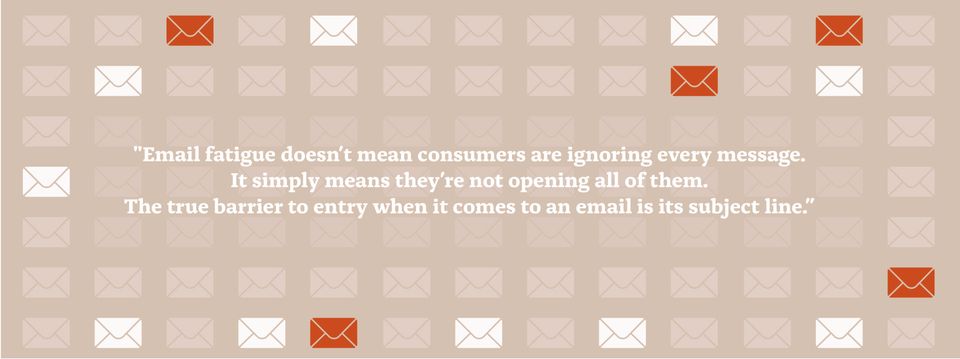Creating valuable content: How to send emails that actually get read
roux LLC • May 7, 2020
Email as a communication tool is a concept that’s been around since the early 1970s, when it was developed and adapted by the U.S. Department of Defense for inter-organizational messaging. At the time it was, of course, a novel concept, and while its inventors likely knew it was revolutionary technology, they probably couldn’t dream up the email-saturated world of 2020.
Internet and email usage became more widespread in the early 1990s, and today it’s nearly impossible to imagine a functioning world—much less a successful business—without it.
Consumers offer up their email addresses at checkout without batting an eye, whether to chain retailers or hometown boutiques. And it’s not limited to retail either; news media, bloggers, influencers and celebrities collect email addresses in exchange for the latest content, whether it’s recipes, gossip, news, or creative writing.
Soon, inboxes are overflowing with content, and consumers quickly fall victim to email fatigue. Because few people take the time to hit ‘unsubscribe,’ whittling their inboxes down to strictly the messages they’re actually interested in, hundreds of emails go unopened every day.
All of that valuable content—and it’s certainly out there—becomes just another shout to the void.
So what makes email relevant?

If you’re wondering why you would ever bother with email, think again.
Email fatigue doesn’t mean consumers are ignoring every message. It simply means they’re not opening all of them. The true barrier to entry when it comes to an email is its subject line.
Consumers need to be told why they should stop and listen to you. Email is still the most direct and influential entry point to a consumer’s brain—they just have to open up the door.
There are multiple tactics for getting that foot in the door, and if you check your email on a regular basis, you’re probably familiar with them.
WordStream blog writer, Megan Marrs, identified some of the most effective tactics in a recent blog post, The 9 Best Email Subject Line Styles to Increase Your Open Rates. We’ll summarize a few of these strategies below and share more of our thoughts on valuable email messaging.
Getting creative with subject lines
In order to be effective, subject lines must indicate the value of the email. Some of the most straightforward examples of this are simple, no-nonsense subject lines that tell the reader exactly what the email contains. These are most often used for confirmation emails or receipts—messages delivering information with no real marketing or persuasion tactics needed.
As companies move beyond those simple, direct emails, subject lines have to get more creative as well, while still telling readers what they need to know or enticing them to click ‘open.’ Marketers can be clever with humor, personalization, or different punctuation and sentence structure, like asking a question or emphasizing with exclamation points or even emojis. All of these tactics are effective in catching readers’ attention and implying that more excitement lies within.
Sometimes, riskier tactics can pay off with subject lines, such as shocking or controversial statements, one-word subject lines, scarcity language, or mystery. The idea behind these strategies is that people will be unable to resist opening the email to find out what’s inside or what your controversial statement truly meant.
If you choose to use those methods, it’s critical that you think carefully about the message you’re trying to send. Is the shock value of your subject line going to offend or annoy readers, or will it be an appropriate attention-grabber? If you’re drawing readers in with a single, mysterious word or the promise of a ‘last-chance sale,’ will they be satisfied with what the email actually contains?
Finally, a tried-and-true blog headline tactic works just as well with email subject lines—numbers and lists. Consumers see a lot of value in lists; they’re able to tell exactly what the email is offering. Whether it’s “7 household cleaners to keep your family germ-free” or “17 mediation techniques to stay calm during uncertain times,” readers see exactly what you’re providing and can decide if it’s something they need.
Valuable content goes deeper than the subject line
Of course, it doesn’t end with the subject line. Nothing is more frustrating for a consumer than being drawn in by a witty subject line or the promise of exclusive information, only to realize it was all a tease. Your open rate may have momentarily spiked, but you certainly didn’t nurture a repeat customer.
As we said before, email is one of the most direct and influential communication tools we’ve been gifted by technology. It’s our duty to use that tool responsibly and to give more than we receive.
Email-driven revenue is a blessing, particularly in the midst of the current COVID-19 pandemic which is keeping customers out of stores and driving them online. As many businesses are surviving solely thanks to e-commerce, it’s critical to go above and beyond for those consumers.
- Be thoughtful with your messaging, beginning with the subject line and continuing throughout the entire message. It is not the time for clickbait, nor is it the time for preying on vulnerability, however easy or tempting it might feel.
- Provide value. If you’re selling an essential good or service, express gratitude for your customers and a willingness to serve. On the flip side, if your business has suddenly become irrelevant, or at the very least, non-essential, what can you offer to your audience? The answer may come in the form of a physical pivot like sewing masks instead of t-shirts, or it may be a softer switch like sending words of encouragement or ideas for at-home activities instead of your typical newsletter content.
- Be authentic. Now more than ever, whatever you’re offering in our emails must align with your brand and your values. As we mentioned in a previous post, inboxes are being inundated with closeout sales, statements on COVID-19, and swift pivots from every corner. If you have to say something, it must be honest, purposeful, and authentic.
Pandemic or not, email is and will continue to be a prime opportunity for your company to engage and connect with its audience. Consider the following questions next time you’re preparing to hit ‘send’:
- What is my purpose in sending this email?
- Does my purpose align with what my audience needs?
If you can’t answer either of those questions or if the answers conflict, it may be time to rethink your strategy.
Thank you for joining us here in the kitchen. We’d love to see you again soon.

We are excited to announce the recipient of our most recent Food for Thought grant — the Hot Springs Food Pantry, located in Hot Springs, South Dakota. Food for Thought is a fund we created through The Community Foundation to offer grants to organizations that help feed children in our community. This isn’t just about money though. We’re also on the lookout for ways to teach kids about good food, to help them learn to prepare it, and to encourage them to love it as much as we do. We are always looking for organizations in our local communities whose mission aligns with ours and have specific needs we can provide grants for. Because our croux reaches far and wide, “local” doesn’t just mean Tennessee. In this case, the community is local to one of our core team members, Lauren. After moving back to her hometown of Hot Springs, South Dakota to be closer to family, she got involved with the local food pantry and saw a specific need there. The food pantry needed a refrigerator so they could provide more fresh produce and protein to families in the area. They were also seeing an above average need in the community due to rising costs which has depleted some of their funds. The grant received from Food for Thought will go towards these efforts and help provide fresh food for families in the area.

We celebrated our 10-year anniversary in July 2023, making this our tenth Mardi Gras as a krewe. We are so thankful for the many projects, partnerships, clients and friends who have been a part of our journey so far. The essence of Mardi Gras can be summed up in one lighthearted phrase, “ Laissez les bons temps rouler!” — French, for “Let the good times roll!” We’ve had a lot of good times here at roux over the last decade, and we’re excited for them to keep on rollin’. Bon Mardi Gras and merci beaucoup, friends!

Every January we like to gather as a croux and plan for the year ahead. It serves as a holiday celebration and a strategy session. We look forward to it every year. Over the last few years, we’ve also begun incorporating a “word of the year” practice, where we each choose a word that we will focus on throughout the year.

We all look forward to receiving Christmas greetings from friends and loved ones, whether it’s a social media post or a physical card to display in our house or hang on the fridge. But when it comes to company Christmas cards, corporate greetings can sometimes fall a bit flat. We love when a company spices things up and sends a message that’s genuine and fun. Videos can also be a more effective and affordable option for a company, when you consider the reach made possible with email and social media, and the savings on printing and postage. Averitt and JetRight are two local companies that knock it out of the park every year when it comes to their video Christmas cards. Whether they choose to be lighthearted and silly or share a heartwarming message, watching their videos shows you the real people and spirit behind the companies. Check them out below!




